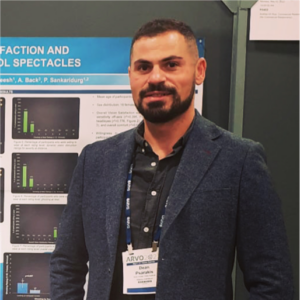November 1, 2023
By Dean Psarakis, BOptom, MSc, Senior Research Optometrist at BHVI

In recent years, much attention has been focused on the ever-growing arsenal of myopia management technologies at our disposal, aimed at mitigating the onward march of myopia. However, the lifestyle risk factors linked to myopia must not be forgotten, with the weight of scientific evidence over the last few decades suggesting that environmental factors are driving the rise in the prevalence of myopia.
In this paper, cross-sectional data from six population-based studies in Asia (12,241 children in total) were analyzed for risk factors and myopia, spherical equivalent refraction (SER), and axial length (AL). The risk factors examined were near work, screen time (including TV), and outdoor time, all of which were determined using questionnaires.
Multivariate analysis found that more total near work, more reading and writing, and less outdoor time were all associated with myopia and SER. AL was also associated with more reading and writing and less outdoor time. Interestingly, screen time was not associated with myopia, AL, or SER.
This study agrees with the already well-established associations between myopia incidence and decreased outdoor time and increased time on near tasks. It reinforces the general guidance optometrists can give to our young patients and their parents when it comes to myopia risk reduction. The role that screen time plays as an independent risk factor is still unclear. As this is a cross-sectional study, only associations can be determined, and as pointed out by the authors, longitudinal data is needed to draw any conclusions on myopia progression.
Abstract
Near Work, Screen Time, Outdoor Time, and Myopia in Schoolchildren in the Sunflower Myopia AEEC Consortium
Lanca C, Yam JC, Jiang WJ, Tham YC, Hassan Emamian M, Tan CS, Guo Y, Liu H, Zhong H, Zhu D, Hu YY, Saxena R, Hashemi H, Chen LJ, Wong TY, Cheng CY, Pang CP, Zhu H, Pan CW, Liang YB, Fotouhi A, Bi HS, Jonas JB, Saw SM; Asian Eye Epidemiology Consortium (AEEC).
Purpose: To examine the association between near work, screen time including TV and outdoor time with myopia in children from the Sunflower Myopia Asian Eye Epidemiology Consortium (AEEC).
Methods: We analyzed AEEC cross-sectional data (12 241 children) on risk factors (near work, screen time including TV and outdoor time) and myopia in six population-based studies (China, Hong Kong, and Singapore). Cycloplegic refraction and axial length (AL) measurements were included. Risk factors were determined using questionnaires. Data were pooled from each study, and multivariable regression analysis was performed to evaluate the associations between risk factors and myopia, spherical equivalent (SE), and AL.
Results: Among the included children, 52.1% were boys, 98.1% were Chinese and 69.7% lived in urban areas. The mean ± standard deviation (SD) for age was 8.8 ± 2.9 years, for SE was −0.14 ± 1.8 D and for AL was 23.3 ± 1.1 mm. Myopia prevalence was 30.6%. In multivariate analysis, more reading and writing (OR = 1.17; 95% CI, 1.11–1.24), more total near work (OR = 1.05; 95% CI, 1.02–1.09) and less outdoor time (OR = 0.82, 95% CI, 0.75–0.88) were associated with myopia (p’s < 0.05). These factors were similarly associated with SE and AL (p’s < 0.05), except for total near work and AL (p = 0.15). Screen time including TV was not significantly associated with myopia (p = 0.49), SE (p = 0.49) or AL (p = 0.83).
Conclusion: In this study, increased reading and writing and decreased outdoor time were associated with myopia. Screen time may be a surrogate factor of near work or outdoor time, but further research is needed to assess its role as an independent risk factor for myopia.
Lanca, C., Yam, J. C., Jiang, W. J., Tham, Y. C., Hassan Emamian, M., Tan, C. S., … & Asian Eye Epidemiology Consortium (AEEC). (2022). Near work, screen time, outdoor time, and myopia in schoolchildren in the Sunflower Myopia AEEC Consortium. Acta ophthalmologica, 100(3), 302-311.
DOI: https://doi.org/10.1111/aos.14942
 |
Dean Psarakis, BOptom, MSc, is a Senior Research Optometrist at the Brien Holden Vision Institute. His research areas have included myopia management and contact lenses. He has 20 years of experience in clinical practice and a passion for delivering eye care services in lower-income settings within Australia and internationally. |













